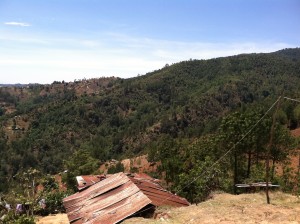The mountains seemed to grow fiercer with every turn of the wheel. Then we stopped and stepped out to a place that seemed frozen in time. A forest as lush as any I have ever seemed. I asked our Mayan guides why this mountain was so lush and the other mountains were so barren. The reply came back sharply, “The people of this region fight for their trees.”
The Mayan Mennonite pastor told us of a protest against deforestation that took place in October of 2012. The people marched and were confronted by government troops. After a brief standoff, the troops opened fire and killed seven people on the Pan-American Highway. Many of the dead were local church people who believed that part of loving Jesus was fighting for their environment.
I was reconvicted that the only way that I can give life is by sacrificing my own.
In this incredibly traditional region, most of the local environmental leaders are women. These are women who refused to be bound by traditional gender roles while the men sold off their spaces of worship and culture. Through their collective sacrifice, life is being created and preserved. The women are taking the people to places of environmental stewardship that the men refused to go.
When women to lead, we get to go to places we previously refused to believe possible.
The Mayan village on the side of the mountain was poor. The dwellings were made out of mud and looked like they could be kicked over. In the past, due to lack of available jobs, men were forced to go to the cities to find work. The women were left behind with little money and kids to feed. Some of the progressive churches in the country combined resources to help with the resulting oppression and malnourishment. They decided to build something that would help the environment and sustain families throughout the year, greenhouses.
Salvation for the women of the villages has come in the form of some posts and plastic.
The greenhouses have revolutionized the villages. The women are able to plant their own environmentally friendly organic crops and sustain themselves. They do not have to rely on anyone else. Traditional gender roles have gone out the window. Now, the men and women take turns doing the cooking and the cleaning. When I had lunch in the village, there were men cooking and serving just the same as the women. The sight was strikingly different than many of the other Mayan villages I have visited, where gender roles are very traditional. By promoting sustainable interaction with the environment, progressive churches are freeing men and women from traditional gender roles.
True environmental consciousness and gender equality in this space were not just topics of scholarly conversation.
Amen.
















